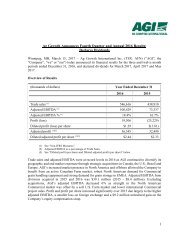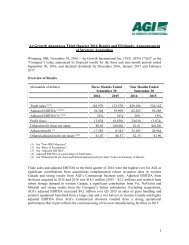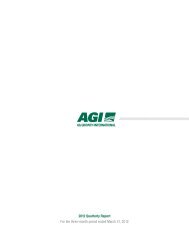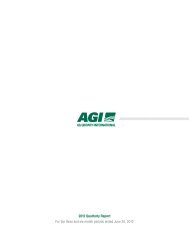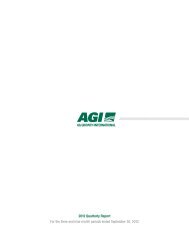2016 Annual Report For Web 7.3MB
You also want an ePaper? Increase the reach of your titles
YUMPU automatically turns print PDFs into web optimized ePapers that Google loves.
activities to which AGI has not yet committed or significant future<br />
investments that will enhance the asset’s performance of the CGU<br />
being tested. These calculations require the use of estimates and<br />
forecasts of future cash flows. Qualitative factors, including market<br />
presence and trends, strength of customer relationships, strength of<br />
local management, strength of debt and capital markets, and degree<br />
of variability in cash flows, as well as other factors, are considered<br />
when making assumptions with regard to future cash flows and the<br />
appropriate discount rate. The recoverable amount is most sensitive<br />
to the discount rate, as well as the forecasted margins and growth<br />
rate used for extrapolation purposes. A change in any of the significant<br />
assumptions or estimates used to evaluate goodwill and other nonfinancial<br />
assets could result in a material change to the results of<br />
operations. The key assumptions used to determine the recoverable<br />
amount for the different CGUs are further explained in note 13.<br />
CGUs are defined as the lowest grouping of integrated assets that<br />
generate identifiable cash inflows that are largely independent of the<br />
cash inflows of other assets or groups of assets. The classification of<br />
assets into CGUs requires significant judgment and interpretations<br />
with respect to the integration between assets, the nature of products,<br />
the way in which management allocates resources and other relevant<br />
factors.<br />
DEVELOPMENT COSTS<br />
Development costs are capitalized in accordance with the accounting<br />
policy described in note 3. Initial capitalization of costs is based on<br />
management’s judgment that technical and economical feasibility is<br />
confirmed, usually when a project has reached a defined milestone<br />
according to an established project management model.<br />
USEFUL LIVES OF KEY PROPERTY, PLANT AND<br />
EQUIPMENT AND INTANGIBLE ASSETS<br />
The depreciation method and useful lives reflect the pattern in which<br />
management expects the asset’s future economic benefits to be<br />
consumed by AGI. Refer to note 3 for the estimated useful lives.<br />
FAIR VALUE OF FINANCIAL INSTRUMENTS<br />
Where the fair value of financial assets and financial liabilities recorded<br />
in the consolidated statements of financial position including the<br />
determination of the fair value of the Company’s available-for-sale<br />
asset cannot be derived from active markets, it is determined using<br />
valuation techniques including the discounted cash flow models. The<br />
inputs to these models are taken from observable markets where<br />
possible, but where this is not feasible, a degree of judgment is required<br />
in establishing fair values. The judgments include considerations<br />
of inputs such as liquidity risk, credit risk and volatility. Changes in<br />
assumptions about these factors could affect the reported fair value of<br />
financial instruments.<br />
SHARE-BASED PAYMENTS<br />
AGI measures the cost of equity-settled share-based payment<br />
transactions with employees by reference to the fair value of equity<br />
instruments at the grant date, whereas the fair value of cash-settled<br />
share-based payments is remeasured at every reporting date.<br />
Estimating fair value for share-based payments requires determining<br />
the most appropriate valuation model for a grant of these instruments,<br />
which is dependent on the terms and conditions of the grant. This also<br />
requires determining the most appropriate inputs to the valuation<br />
model including the expected life of the option, volatility and dividend<br />
yield.<br />
INCOME TAXES<br />
Uncertainties exist with respect to the interpretation of complex<br />
tax regulations, changes in tax laws and the amount and timing of<br />
future taxable income. Given the wide range of international business<br />
relationships and the long-term nature and complexity of existing<br />
contractual agreements, differences arising between the actual results<br />
and the assumptions made, or future changes to such assumptions,<br />
could necessitate future adjustments to taxable income and expenses<br />
already recorded. AGI establishes provisions, based on reasonable<br />
estimates, for possible consequences of audits by the tax authorities<br />
of the respective countries in which it operates. The amount of such<br />
provisions is based on various factors, such as experience of previous<br />
93 CONSOLIDATED FINANCIAL STATEMENTS<br />
FIELD TO CONSUMER<br />
<strong>2016</strong> ANNUAL REPORT<br />
CONSOLIDATED FINANCIAL STATEMENTS 94



